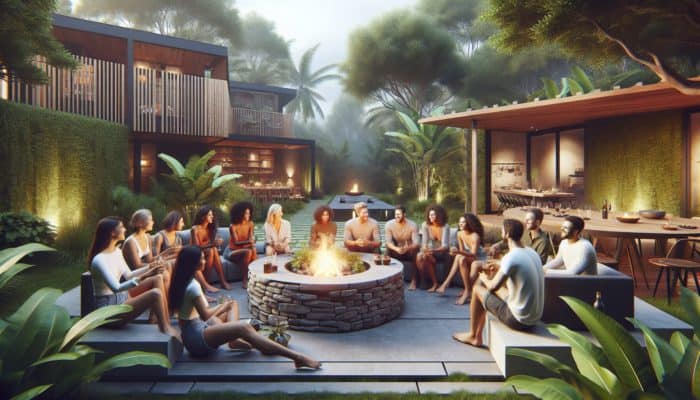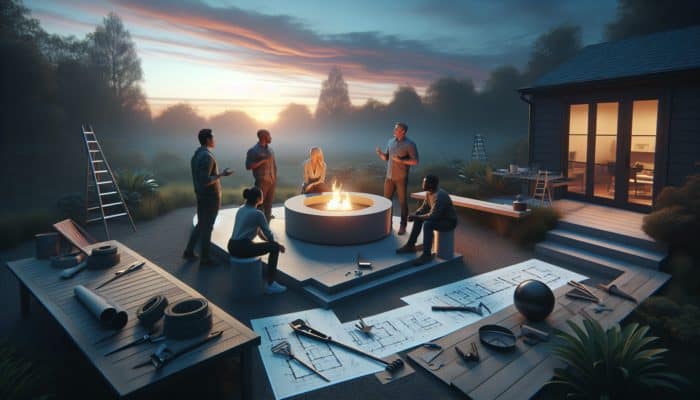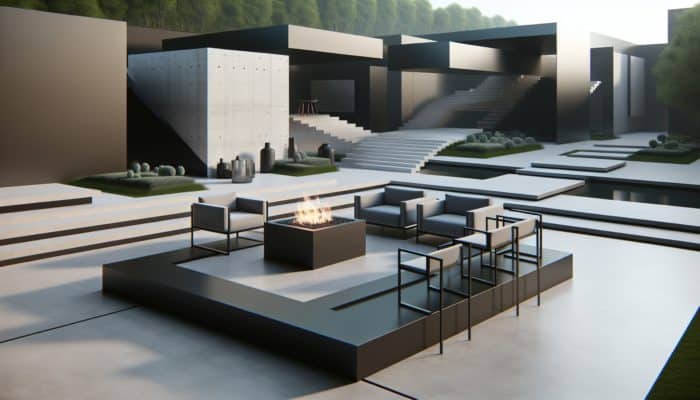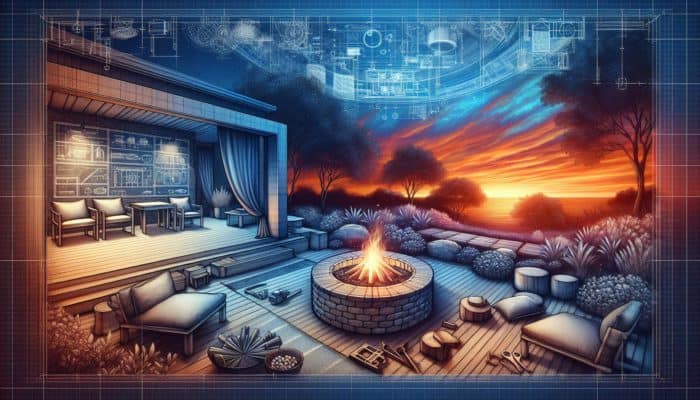Comprehensive Guide to Fire Pit Construction
What Exactly Is a Fire Pit?

Fire Pit Construction: A fire pit is an outdoor feature specifically designed to safely contain a fire, primarily used for creating ambience, providing warmth, or for cooking purposes. These adaptable installations serve a dual role: they enhance the visual appeal of outdoor areas while also offering a communal space for social interactions. Based on the intended function, fire pits can range from straightforward designs to intricate setups, crafted from a variety of materials and styles to suit different environments and uses. Their designs can vary widely, from rustic stone constructions nestled in a garden to sleek contemporary models positioned on a patio, catering to the diverse preferences of homeowners globally.
Fire pits are engineered to safely contain fire, allowing heat and light to radiate into the surrounding area. This makes them perfect for a myriad of outdoor activities, including family gatherings, romantic evenings, or casual barbecues. With the rising popularity of outdoor living spaces, fire pits have become essential features in homes, creating a snug atmosphere throughout the year. Additionally, they can provide a distinctive cooking experience, transforming a simple backyard into an enticing culinary space where one can grill, roast, or relish the warmth in the company of friends and family.
Exploring the Various Types of Fire Pits
Fire pits can be classified into several categories, including wood-burning, gas, and Propane options. Each type offers unique benefits and factors to consider regarding installation and maintenance.
Wood-burning fire pits are the traditional choice, offering a natural and rustic experience. They create a captivating ambience with the crackling sounds of burning wood and radiant flames. The aroma of burning wood enhances the sensory experience, making these fire pits perfect for evoking a campfire atmosphere in your backyard. However, they do require more upkeep, including ash disposal and frequent cleaning, and may be subject to local fire regulations.
Gas fire pits, powered by either natural gas or propane, provide ease and control. They can be ignited with the simple flip of a switch, delivering a consistent flame without the need for firewood. Many homeowners prefer gas fire pits for their cleanliness, as they produce significantly less smoke and ash compared to traditional fire pits. However, they may necessitate a more complex installation process and incur ongoing fuel costs.
Propane fire pits are portable and versatile, making them ideal for those who seek a fire pit without the commitment of a permanent structure. They can be repositioned according to immediate needs, whether for camping adventures or backyard socialising. Their designs often mimic traditional wood-burning pits, providing visual appeal without the associated hassle of wood.
Why You Should Consider Adding a Fire Pit to Your Space
Fire pits significantly enhance outdoor living spaces by providing warmth, serving as a focal point for gatherings, and offering opportunities for cooking. They can substantially increase property value while creating memorable experiences for family and friends.
One of the primary advantages of having a fire pit is its ability to create an outdoor social hub. Fire pits encourage people to gather, making them a vital feature for entertaining guests or spending quality time with family and friends. The warmth emanating from the fire extends the enjoyment of outdoor spaces, allowing for comfortable gatherings even during cooler months.
Beyond their social function, fire pits also inspire culinary creativity. They can be utilised for roasting marshmallows, grilling meats, or preparing a variety of dishes over an open flame. This capacity for outdoor cooking enhances the functionality of your space, making it suitable for a wide range of activities.
Moreover, fire pits can act as striking visual elements in your landscape design. Thoughtfully designed, they can become a focal point that complements your garden, patio, or overall backyard layout. This aesthetic enhancement can elevate your outdoor area, attracting attention and admiration from visitors.
Strategising Your Fire Pit Installation

How to Choose the Perfect Location for Your Fire Pit
Selecting the ideal location for your fire pit is essential for both safety and enjoyment. Consider factors such as wind direction, proximity to structures, and accessibility to ensure a pleasant experience.
Key considerations for location include:
- Distance from flammable structures like trees, fences, and buildings.
- Wind direction is used to prevent smoke from blowing into seating areas.
- Accessibility for guests and easy access to firewood or propane tanks.
- Ground stability is needed to support the structure and prevent sinking.
- Proximity to seating arrangements for comfort and warmth.
- Local regulations regarding the placement and safety of fire pits.
Choosing the right spot for your fire pit may also involve considering the overall design of your outdoor space. Ideally, a fire pit should integrate seamlessly with your existing landscaping and outdoor furniture to create a cohesive environment. Consider creating a natural gathering area that fosters interaction, positioning the fire pit centrally among seating arrangements.
What Size Fire Pit Will Best Suit Your Needs?
The size of your fire pit should be determined by the available space, the number of people it will serve, and its intended use. A larger pit may be more suitable for bigger gatherings, while a smaller one could provide a more intimate setting.
When planning the size of your fire pit, consider how many people you typically entertain. For larger groups, a fire pit with a diameter of 36 inches or more ensures that everyone can gather comfortably around the flame. Conversely, a compact fire pit, around 24 to 30 inches, is ideal for smaller gatherings or intimate settings, allowing for cozy conversations without overwhelming the space.
Another aspect to consider is the fire pit’s purpose. If you plan to cook over the fire, you may need a larger pit that can accommodate a grill or cooking grate. Alternatively, if the primary goal is warmth and ambience, a smaller, decorative model may suffice.
Lastly, consider the layout of your outdoor space. A large fire pit in a small yard can feel overcrowded, while a small pit in a spacious area may appear insignificant. Striking the right balance between size and space enhances both functionality and aesthetic appeal.
Design Considerations for Your Fire Pit

The design of your fire pit should harmonise with your outdoor space. Consider the shape, materials, and surrounding landscaping to create a cohesive and visually appealing area.
Aesthetics play a crucial role in the overall appeal of your fire pit. Common shapes include circular, square, and rectangular designs, each offering a unique atmosphere. Circular fire pits often provide a more traditional appearance, enhancing the classic campfire experience. In contrast, square or rectangular pits can impart a more modern feel, often integrating seamlessly into contemporary outdoor designs.
Material selection also impacts aesthetics. Options like natural stone convey a rustic charm, while sleek metal designs can evoke a contemporary style. Utilising materials that match or complement your home’s architecture creates a harmonious look. Landscaping around the fire pit can enhance its appeal; consider adding seating, decorative stones, or plants to create an inviting atmosphere.
Furthermore, lighting plays a pivotal role in the evening ambience. Incorporating lights around the fire pit or using decorative lanterns can elevate your outdoor setting, making it enjoyable at night. Designing with these elements in mind ensures that your fire pit serves not only a functional purpose but also enhances the visual beauty of your outdoor space.
Essential Materials for Fire Pit Construction
Common Materials Utilised in Fire Pit Construction
Fire pits can be constructed from various materials, including brick, stone, concrete, and metal. Each material possesses distinct aesthetic and functional properties that influence the overall design and durability.
Brick is a popular choice for its classic appearance and durability. It withstands high temperatures and offers good insulation. Brick fire pits can be constructed in a variety of shapes and sizes, allowing for customization and personalization. However, they may require more maintenance to prevent crumbling over time.
Stone provides a natural and rustic appearance. It can often be sourced locally, which may reduce costs and the environmental impact. Stone fire pits are incredibly robust and can endure extreme heat, making them an excellent long-term investment. However, installation can be labour-intensive, requiring skilled craftsmanship for a professional finish.
Concrete is another common option, known for its versatility. It can be moulded into various shapes and can be painted or stained to achieve your desired aesthetic. Concrete fire pits are durable and require minimal maintenance; however, it is essential to use heat-resistant varieties to prevent cracking.
Metal fire pits, often made from steel or cast iron, are lightweight and portable, making them easy to transport. They heat up quickly and provide a unique modern aesthetic. However, they can rust over time, necessitating regular maintenance and protective coatings to extend their lifespan.
How Do You Choose the Right Material for Your Fire Pit?
Selecting the appropriate material for your fire pit depends on factors such as budget, desired appearance, and maintenance requirements. Each material presents distinct advantages and potential drawbacks that must be considered.
First, evaluate your budget. Brick and stone can be more expensive upfront due to material costs and labour, while metal options often provide a budget-friendly alternative. However, investing in high-quality, durable materials can save money in the long run, as they require fewer repairs and replacements over time.
Next, consider the aesthetic you wish to achieve. If you desire a natural, rustic feel, brick or stone may be the right choice. For a more contemporary look, consider a sleek metal design. Additionally, ensure the material matches your home’s existing architecture and landscape to promote visual harmony.
Maintenance requirements are another critical factor. Metal fire pits often need regular protection against rust and corrosion, while brick and stone may require periodic sealing to prevent damage from moisture or heat. Understanding your willingness to perform regular maintenance will ultimately guide your material choice.
Lastly, consider the fire pit’s intended use. If you plan to cook, ensure the material can withstand higher temperatures and is suitable for food preparation. Choosing the right material guarantees that your fire pit is not only visually appealing but also functional and durable.
How to Source Quality Materials for Your Fire Pit
Finding high-quality materials for your fire pit is essential for longevity and safety. Look for reputable suppliers and consider the environmental impact of your choices to ensure a responsible construction process.
Begin by researching local suppliers who specialise in outdoor materials. Visiting supply yards allows you to assess the quality of materials available and inspect them firsthand. Checking online reviews and soliciting recommendations from friends or local contractors can also help identify trustworthy suppliers.
Consider sourcing materials that are sustainably produced or locally sourced. This approach minimises your environmental footprint and supports local economies. Many stone suppliers offer options that are quarried nearby, reducing transportation emissions and promoting eco-friendly practices.
When purchasing, inquire about warranties and guarantees on the materials. Quality suppliers often provide assurances on their products, ensuring you receive durable materials that meet safety standards. This aspect is crucial for a long-term investment in your fire pit project.
Finally, do not hesitate to ask for samples or small quantities before committing to a larger purchase. This allows you to test the materials for durability, heat resistance, and overall appearance, ensuring they meet your expectations before full-scale construction.
Preparing Materials for Fire Pit Construction
Proper preparation of materials, such as cutting stones or treating metal, is crucial for a safe and aesthetically pleasing fire pit construction. Taking the time to prepare ensures that the materials fit well together, enhancing both functionality and visual appeal.
Begin by assessing the requirements of each material before construction. For stones, ensure they are cut to the appropriate size and shape. Using a masonry saw or chisel can help achieve clean edges, which not only improves appearance but also allows for better stacking and stability in the overall structure.
For metal materials, apply a heat-resistant coating to prevent rust and wear over time. This treatment is particularly important for fire pits made from steel or cast iron. Applying a protective finish can prolong the life of your fire pit and maintain its aesthetic appeal.
Additionally, cleaning materials before use can prevent contaminants from affecting the fire. Dust, dirt, or oils can impact how materials withstand heat and burn. Ensure that all surfaces are clean and dry before beginning any construction.
Finally, consider the assembly of materials carefully. Using high-quality adhesives or mortar for bricks and stones, or ensuring proper welding techniques for metal structures, is vital to achieving a sturdy and safe fire pit. Adequate preparation sets the foundation for a thriving outdoor feature.
Cost Comparison of Various Fire Pit Materials
Understanding the cost differences between materials such as brick, stone, concrete, and metal can help you budget and select the most economical option for your fire pit. Each material varies not only in initial price but also in long-term maintenance and durability costs.
Brick fire pits typically range from $200 to $1,200, depending on the quality and type of brick used. While they offer a classic look, their installation may require professional assistance, which can add to the overall cost.
Stone is often the most expensive material, costing between $500 and $2,500 per square foot. However, its durability and aesthetic appeal can justify the investment, especially in regions where the living phenomenon is prevalent year-round.
Concrete offers a mid-range option, with costs varying from $300 to $1,500. The versatility of concrete enables a wide range of designs, making it a popular choice among many homeowners. It requires less maintenance than natural materials, which can offset initial costs over time.
Metal fire pits are generally the most affordable, with prices ranging from $100 to $800. However, the longevity of metal products can vary significantly based on the materials used and treatments applied. Investing in high-quality metals can mitigate future replacement costs.
Ultimately, when budgeting for your fire pit, factor in both initial costs and ongoing maintenance to ensure a sustainable investment that meets your needs and enhances your outdoor living experience.
Expert Insights on Fire Pit Construction
What Are the Recommended Practices for Fire Pit Construction?
Best practices for fire pit construction include ensuring proper ventilation, using heat-resistant materials, and adhering to local building codes and regulations. Implementing these guidelines enhances safety and functionality, creating a successful fire pit experience.
- Ensure proper ventilation to allow smoke to escape and prevent buildup.
- Use heat-resistant materials to withstand extreme temperatures.
- Follow local building codes and regulations to comply with safety standards.
- Consider the wind direction and surrounding structures when selecting a location.
- Maintain a safe distance from flammable materials, such as furniture and trees.
- Incorporate safety features, such as spark screens or fire-retardant barriers, to enhance protection.
- Regularly inspect and maintain the fire pit to ensure long-term durability.
- Consult with professionals if you are unsure about the structural integrity or design.
The importance of safety measures cannot be overstated. Proper ventilation prevents the accumulation of dangerous smoke, while using suitable materials protects against fire hazards. Ensuring compliance with local codes can also save you from potential fines or accidents arising from unsafe construction practices.
Moreover, safety features such as spark screens can further enhance usability by preventing embers from escaping the fire pit and igniting nearby materials. Regular inspections and maintenance help identify wear and tear before it becomes a significant issue, ensuring that your fire pit remains a safe and enjoyable space for years to come.
How Can You Ensure Safety During Fire Pit Construction?
Safety is paramount in fire pit construction. Ensuring adequate distance from flammable materials, installing a spark screen, and having fire-extinguishing tools nearby are crucial steps to mitigate risks.
To maintain safety, it’s essential to:
- Position the fire pit at least 10-20 feet away from structures, trees, and other flammable items.
- Choose a non-combustible surface, such as gravel or stone, to build your fire pit.
- Install a spark screen to minimise the risk of embers escaping.
- Have fire-extinguishing tools, such as a bucket of sand or a fire extinguisher, within reach.
- Use seasoned wood or approved fuel types to minimise smoke and emissions.
- Never leave a fire unattended, and ensure it is completely extinguished when finished.
- Regularly clean out ash and debris to prevent flare-ups.
- Educate family members on fire safety practices and the proper use of the fire pit.
Taking these precautions ensures a safer environment for you and your guests. The positioning of your fire pit is crucial; maintaining a safe distance from flammable materials significantly decreases the risk of unintended fires.
Additionally, using seasoned wood reduces smoke and helps avoid fire hazards associated with burning green or treated wood. Regular cleaning and maintenance keep your fire pit functioning safely and effectively. Educating everyone who uses the fire pit about safety practices can foster a culture of responsible use, ensuring enjoyable experiences for all.
Common Pitfalls to Avoid When Constructing a Fire Pit
Common mistakes in fire pit construction include improper sizing, neglecting safety features, and using unsuitable materials. Understanding these pitfalls can help prevent costly errors and ensure a successful project.
One significant mistake is selecting the wrong size. A fire pit that is too large can overwhelm a small space, while one that is too small may not serve its intended purpose. Consider the size of your outdoor area and the number of people you wish to accommodate when deciding on dimensions.
Neglecting safety features is another prevalent error. Fire pits must be designed with safety in mind, ensuring adequate ventilation and utilizing heat-resistant materials. Failing to incorporate these elements can lead to hazardous issues down the line.
Additionally, using unsuitable materials can result in short-term savings but long-term problems. Materials that cannot withstand high heat or exposure to outdoor elements will deteriorate rapidly, posing potential safety hazards. Invest in durable materials that suit your climate and intended use.
Finally, failing to consider local ordinances and regulations can result in fines or necessitate costly modifications. Always consult local guidelines regarding fire pit construction to ensure compliance and safety.
What Materials Are Best for Fire Pit Construction?
Choosing the right materials is crucial for durability and safety. Options include fire-resistant bricks, steel, and heat-resistant concrete. Understanding the pros and cons of each material can guide your decision-making process.
Fire-resistant bricks are ideal for their durability and heat absorption properties. They can withstand high temperatures and contribute to the overall safety of your fire pit. However, they may require a higher initial investment and professional installation.
Steel is another excellent option, offering strength and portability. Steel fire pits heat up quickly, providing warmth when needed. However, they can rust over time, necessitating the application of protective coatings or treatments to ensure longevity.
Heat-resistant concrete is a versatile material that enables a wide range of designs. It is durable and requires minimal maintenance, making it a popular choice for modern fire pits. However, ensure that you use a high-quality mix designed to withstand extreme temperatures.
Ultimately, the choice of materials will depend on your design preferences, budget, and local climate conditions. Investing in quality materials ensures a safe and long-lasting fire pit that enhances your outdoor experience.
How to Maintain Your Fire Pit for Longevity?
Regular maintenance ensures your fire pit lasts longer, providing safety and enjoyment for years to come. Cleaning ashes, inspecting for cracks, and applying heat-resistant sealants are essential steps in the maintenance process.
Start by cleaning your fire pit after each use. Remove ashes and debris to prevent buildup, which can obstruct airflow and affect performance. A clean fire pit also reduces the risk of flare-ups, ensuring a safer environment.
Inspect your fire pit periodically for any signs of damage or wear. Look for cracks in stone or concrete, rust on metal components, or loose bricks. Addressing these issues promptly can prevent larger problems down the line.
Applying heat-resistant sealants can protect your fire pit from moisture and heat damage. This step is especially crucial for stone or concrete fire pits, which can be prone to cracking due to temperature fluctuations. Ensure that the sealant is designed for outdoor use and apply it as recommended.
Additionally, consider seasonal maintenance. In colder months, cover your fire pit to protect it from the elements and prevent rust or damage. If you live in areas with harsh winters, storing your fire pit indoors may be a wise choice to prolong its lifespan.
Constructing Your Fire Pit: A Step-by-Step Guide
Comprehensive Steps to Build Your Fire Pit
A detailed guide can assist you through the process of building your fire pit, from site preparation to the final touches. Carefully following each step ensures a sturdy and functional fire pit that enhances your outdoor space.
1. Site Preparation: Begin by selecting the right location, ensuring it is free from flammable materials and well-ventilated. Clear the area of debris, levelling the ground if necessary to provide a stable base.
2. Digging the Pit: Depending on the design, dig a hole that matches your desired size and depth. The standard depth for a fire pit is about 12 inches, allowing for proper airflow and heat retention.
3. Building the Base: Lay down a base layer of gravel or sand to promote drainage and stabilise the structure. This layer should be about 2-4 inches thick, providing a solid foundation.
4. Constructing the Walls: Depending on your chosen materials, begin stacking bricks, stones, or pouring concrete to form the walls of your fire pit. Ensure that each layer is level and secure, making adjustments as necessary.
5. Creating a Fire Ring: If using bricks or stones, consider lining the inner wall with fire-resistant bricks to provide additional heat protection. This helps prevent damage to the outer structure.
6. Finishing Touches: Once the walls are complete, add any decorative elements or seating arrangements around the fire pit. Consider adding a spark screen or lid to enhance safety and usability.
7. Final Inspection: Before use, inspect the entire structure for stability and safety. Ensure that all components are secure and that the fire pit is free from debris.
By following these steps, you can construct a fire pit that serves as a focal point for gatherings, providing warmth and entertainment for years to come.
What Tools Are Required for Building a Fire Pit?
Essential tools for fire pit construction include shovels, levels, trowels, and possibly a masonry saw. Having the right tools can streamline the process and enhance efficiency, ensuring a successful build.
Start with basic hand tools such as a shovel for digging the pit and preparing the site. Depending on the materials used, you may also need a level to ensure that your fire pit walls are even and stable. This step is crucial for both safety and aesthetic purposes.
A trowel is essential for applying mortar or levelling out the walls of your fire pit. Whether working with bricks or stones, a trowel helps achieve a clean finish and secure placement of each piece.
If you are using stone or brick, a masonry saw may be required to cut materials to size for a perfect fit. This tool is especially useful when working with larger stones that need to be shaped to fit your design.
Additionally, consider having safety gear on hand, such as gloves and goggles, to protect yourself during the construction process. A measuring tape will also be helpful to ensure accurate dimensions and spacing.
Finally, a bucket or wheelbarrow can assist with transporting materials, helping to streamline the overall process. Having all the necessary tools and equipment ready will enhance your efficiency and outcome when building your fire pit.
Final Touches and Landscaping Around Your Fire Pit
After constructing your fire pit, consider adding finishing touches like seating, lighting, and landscaping to enhance its functionality and aesthetic appeal. These details create a welcoming environment that encourages outdoor enjoyment.
Start by arranging comfortable seating around your fire pit. Options include outdoor chairs, benches, or even built-in seating made from stone or wood. Ensure that seating is positioned at a safe distance from the fire while still allowing for easy engagement and conversation.
Incorporating lighting can extend the usability of your fire pit into the evening. Consider using string lights, lanterns, or even built-in LED lighting to create a warm and inviting atmosphere. Soft lighting enhances the ambience while providing safety for navigating the area.
Landscaping around your fire pit is another essential step. Use decorative gravel, stones, or pavers to define the area and create a visually appealing border. Consider adding plants or flowers to soften the surroundings and integrate the fire pit into the overall landscape design.
Finally, think about protective features such as a cover or spark screen. These elements not only enhance safety but can also add to the overall design aesthetic. By incorporating these finishing touches, your fire pit will become a stunning focal point in your outdoor space, ready for use and enjoyment.
Ongoing Maintenance and Care for Your Fire Pit
Essential Routine Maintenance Tips for Your Fire Pit
Regular maintenance of your fire pit involves cleaning out ash and debris, checking for structural integrity, and ensuring all components are functioning properly. This consistent care is essential for safety and longevity.
Start with the ash removal process. Ideally, clean out ashes after each use to prevent buildup, which can obstruct airflow and create safety hazards. Use a metal shovel or ash vacuum designed for fire pits to remove the residue safely.
Inspect your fire pit regularly for signs of wear and tear. Look for cracks in the structure, rust on metal components, or loose bricks. Addressing these issues early on can prevent larger, more costly repairs down the line.
Additionally, check any safety features, such as spark screens or lids, to ensure they are functioning correctly. Replace any damaged parts immediately to maintain a safe environment for use.
Consider performing a more thorough maintenance check at the start of each season. This includes cleaning, inspecting for structural integrity, and applying any necessary treatments or sealants to protect your fire pit from the elements.
By maintaining a regular maintenance routine, you ensure that your fire pit remains safe, functional, and aesthetically pleasing for years to come.
How Frequently Should You Clean Your Fire Pit?
The frequency of cleaning your fire pit depends on usage. Generally, cleaning after each use is recommended to prevent buildup and maintain safety.
After each use, remove ashes and debris from the fire pit. This practice prevents excessive accumulation, which can hinder airflow and impact fire performance. Proper disposal of ashes is also vital; ensure they are fully extinguished and cooled before disposing of them safely.
In addition to post-use cleaning, perform a more thorough cleaning at least once a month, especially during peak usage seasons. This cleaning can include scrubbing down the walls and base to remove soot, as well as inspecting for any signs of damage or wear.
If your fire pit is exposed to the elements, consider cleaning it more frequently to prevent damage. Rain, snow, and debris can accelerate the deterioration process. Regular inspections during adverse weather can help identify any issues early, allowing for prompt repairs.
Ultimately, the key to longevity lies in regular cleaning and maintenance. Keeping your fire pit clean not only ensures safety but enhances the overall experience, allowing you to enjoy warm gatherings around the fire without concern.
Seasonal Care and Protection for Your Fire Pit
Seasonal care includes covering your fire pit during off-seasons to protect it from the elements and performing any necessary repairs or upgrades before the next use. Taking these steps prolongs the life of your fire pit and enhances its functionality.
During winter months or periods of non-use, consider covering your fire pit with a durable, weather-resistant cover. This cover protects against snow, rain, and debris, preventing damage and reducing maintenance needs when you are ready to use it again.
Before the start of the outdoor season, inspect your fire pit for any signs of wear or damage that may have occurred during the off-season. Check for rust on metal components, cracks in stone or concrete, and ensure that all safety features are intact.
If you notice any damage, address it promptly. For example, apply rust-resistant sprays to metal surfaces, or reseal concrete if cracks appear. This proactive approach ensures your fire pit remains in excellent condition and ready for use when the weather turns favourable.
Additionally, consider upgrading features or accessories during the off-season to enhance your experience. Installing new seating or lighting can enhance the overall appeal of your fire pit, making it a more inviting spot for gatherings.
By prioritising seasonal care, you keep your fire pit in optimal condition, making it a safe and enjoyable feature in your outdoor space year-round.
Troubleshooting Common Fire Pit Issues
Learn to identify and resolve common fire pit issues, such as poor ignition, uneven burning, and smoke problems, to keep your fire pit in optimal condition. Recognising these problems early can enhance your fire pit’s performance and safety.
If you experience poor ignition, ensure that your fuel source is adequate and that your fire pit is clean. Remove any debris that may obstruct airflow, and consider using dry, seasoned wood or appropriate fuel types to promote easier ignition.
Uneven burning can result from improper stacking of wood or insufficient airflow. Ensure that logs are arranged in a way that allows for proper ventilation and air circulation. Avoid overcrowding the fire pit, as this can suffocate the flames and lead to inefficient burning.
Excessive smoke can be attributed to wet or green wood, which produces more smoke than dry wood. Always use seasoned firewood for a cleaner, more efficient burn. Additionally, check for blockages in the chimney or flue if applicable, as these can impede smoke flow and create hazards.
Regularly inspect your fire pit for structural integrity, looking for any signs of wear or damage that may compromise its performance. Addressing these problems proactively ensures that your fire pit operates safely and effectively.
Effective Long-Term Storage Solutions for Your Fire Pit
Discover effective methods for storing your fire pit during extended periods of non-use, including disassembly tips and protective measures to ensure longevity. Proper storage techniques can prolong the life of your investment.
For portable fire pits, disassembly is often the best approach. Follow the manufacturer’s guidelines for disassembly to prevent damage and ensure all parts are accounted for. Store components in a dry, cool place, ideally indoors, to protect against moisture and temperature extremes.
If your fire pit is permanent, consider covering it with a weather-resistant tarp or specially designed cover. This practice protects the fire pit from rain, snow, and debris while preventing rust and deterioration.
Before storing, thoroughly clean the area to remove any ash, debris, or residue. Allow it to dry completely to prevent moisture buildup, which can lead to mould or rust during storage.
If applicable, check for any loose components or damage before covering or storing your fire pit. Please address any issues immediately to ensure it operates safely and effectively when you are ready to use it again.
By following these storage solutions, you can extend the life of your fire pit, ensuring it remains a functional and beautiful feature of your outdoor space for years to come.
Maximising Your Fire Pit Experience
Incorporating Accessories and Features
Enhance your fire pit with accessories such as cooking grates, spark screens, and decorative elements to increase its functionality and appeal. These additions can transform your fire pit into a multifunctional outdoor feature that caters to various activities.
Cooking grates are a popular accessory that allows you to use your fire pit for grilling or roasting. They come in various sizes and materials, ensuring compatibility with your fire pit design. This feature enhances the culinary possibilities, making your outdoor space more versatile for meals and gatherings.
Spark screens are essential for safety, as they prevent embers from escaping and igniting nearby materials. They come in various styles and sizes, providing both functionality and aesthetic appeal. Installing a spark screen adds an extra layer of safety while enhancing the visual allure of your fire.
Additionally, consider decorative elements such as fire pit rings or custom stonework to personalise your fire pit. These features can elevate the overall look, making your fire pit a stunning centrepiece in your outdoor space.
Seating arrangements also play a crucial role in enhancing the fire pit experience. Comfortable, inviting seating encourages gatherings and promotes interaction among guests. Consider built-in benches, cushions, or outdoor furniture that complements the fire pit’s design.
Incorporating these accessories not only enhances the fire pit’s functionality but also creates a welcoming atmosphere for family and friends to enjoy.
What Are Some Creative Uses for Your Fire Pit?
Fire pits can be used for more than just warmth. Consider using them for cooking, roasting marshmallows, or as a focal point for outdoor events and gatherings.
One creative use for your fire pit is hosting cooking experiences. You can grill meats, prepare pizzas, or even bake bread over an open flame. This unique culinary approach adds excitement to outdoor meals, creating memorable experiences for your guests.
Roasting marshmallows and making s’mores is a timeless activity for gatherings around the fire. Set up a roasting station with skewers and ingredients for a fun, interactive dessert experience. This activity appeals to both children and adults, fostering a sense of nostalgia and community.
Furthermore, consider using your fire pit as a focal point for outdoor events. During gatherings, you can arrange seating around the fire pit, encouraging conversation and connection among guests. Incorporating ambient lighting, such as string lights or lanterns, enhances the atmosphere, making it perfect for evening events.
Additionally, using the fire pit for storytelling or sharing experiences during gatherings creates a cosy ambiance that encourages bonding. This shared experience can transform ordinary events into cherished memories.
By exploring these creative uses, your fire pit becomes more than just a source of warmth; it evolves into a multifunctional centrepiece that enriches your outdoor living experience.
Integrating Fire Pits into Your Outdoor Living Spaces
Fire pits can serve as a central element in your outdoor living space, around which you can arrange seating, landscaping, and other features to create a cohesive and inviting area.
To effectively integrate a fire pit, consider its location within your overall outdoor layout. Position it at the heart of your gathering space, ensuring easy access to seating and pathways. This arrangement encourages social interaction and enhances the usability of the area.
When designing your outdoor space, consider how the fire pit complements the existing features. For instance, if you have a patio, consider using pavers or materials similar to those of the stonpithe fire pit’s materials to create a uniform look. This design approach fosters visual harmony and enhances the aesthetic appeal of your environment.
Incorporating landscaping elements around the fire pit can also enhance its integration. Use plants, shrubs, or decorative stones to create natural boundaries that frame the fire pit, enhancing its appeal while providing a sense of enclosure.
Finally, consider incorporating additional outdoor features such as an outdoor kitchen or dining area nearby. This integration creates a cohesive outdoor living experience, inviting guests to transition seamlessly between cooking, dining, and enjoying the warmth of the fire.
By thoughtfully integrating your fire pit into your outdoor living space, you create a welcoming and functional environment that encourages relaxation and social interaction.
Selecting the Appropriate Fuel for Your Fire Pit
Choose between wood, propane, or natural gas based on your needs for convenience, cost, and environmental impact to optimise your fire pit experience. Each fuel type offers distinct advantages and considerations that influence your decision.
Wood provides a traditional fire experience, delivering a captivating ambience with the crackling sound and aroma of burning logs. Wood is often the most cost-effective option for those who have access to it, providing a nostalgic outdoor experience. However, it requires proper storage and handling, as well as regular maintenance to keep the pit clean and functioning properly.
Propane is a convenient fuel option, allowing for easy ignition and consistent heat. It’s ideal for those who want a low-maintenance fire pit experience without the hassle of dealing with wood. However, the ongoing cost of propane can add up, and you must ensure that tanks are stored and maintained properly.
Natural gas offers a permanent solution for those who prefer convenience. It provides a steady fuel source without the need for refilling tanks. However, installation may require professional assistance to connect to your home’s gas line. While it eliminates the hassle of fuel management, ensure that you comply with local safety regulations.
Ultimately, the right fuel choice will depend on your lifestyle, preferences, and access to resources. Consider the trade-offs of each option to select the fuel type that best meets your needs while maximising your fire pit experience.
Essential Safety Tips for Using Fire Pits
Ensure a safe environment by keeping a fire extinguisher nearby, never leaving the fire unattended, and maintaining a safe distance from flammable materials. Practicing these safety tips enhances your fire pit experience, allowing for worry-free enjoyment and having a fire extinguisher nearby by hand. This precautionary measure ensures that you are prepared for any unforeseen flare-ups or emergencies. Familiarise yourself with how to use fire extinguishing tools effectively to act quickly if needed.
Never leave the fire when anyone is present in the presence of children or pets. Constant supervision ensures that the fire remains controlled and reduces the risk of accident. It is crucial to extinguish the fire; doing so is crucial.
Maintain a safe distance between your fire pit and any flammable materials. This distance should be at least 10-20 feet to prevent ignition of nearby structures, furniture, or foliage.
Finally, educate everyone using the fire pit about safety practices, including how to manage the event and an emergency in case of an emergency. Knowledgeable users can help promote a safe and enjoyable fire pit experience for all.
Research-Backed Advantages of Fire Pit Construction
How Does a Fire Pit Enhance Outdoor Living?
Fire pits can significantly enhance outdoor living by providing a gathering spot, increasing property value, and offering a source of warmth and ambience.
- Creates a natural focal point for gatherings, encouraging social interaction.
- Provides warmth for year-round outdoor entertaining, extending usability.
- Enhances the aesthetic appeal of outdoor spaces with stylish designs.
- Encourages outdoor cooking experiences, promoting culinary creativity.
- Increases property value by adding desirable outdoor features.
- Facilitates relaxation, enjoyment, and joy of nature in one’s own backyard.
- Offers versatile functionality for various activities, from roasting marshmallows to storytelling.
- Contributes to a cosy ambience that fosters memorable moments with family and friends.
To maximise these benefits, consider how to arrange your outdoor space around the fire pit, ensuring attractive seating and landscaping. These elements create an inviting atmosphere that draws people outdoors and encourages social gatherings.
Additionally, think about how your fire pit can facilitate various activities, such as cooking or storytelling. These functions encourage interaction and enjoyment, adding depth to your outdoor living experience.
Ultimately, investing in a fire pit not only enhances your outdoor space but also provides a versatile setting for memorable moments and cherished experiences with loved ones.
Psychological Advantages of Fire Pits
Studies show that fire pits can promote relaxation, reduce stress, and foster social connections. The soothing nature of fire can have a calming effect on the mind and spirit, enhancing overall well-being.
The ambience created by a fire pit encourages people to gather and unwind. The warmth and flickering flames create a natural gathering spot, facilitating conversations and connections among friends and family. This social interaction is vital for mental health, as it promotes bonding and shared experiences that strengthen relationships.
Moreover, the simple act of sitting around a fire can induce mindfulness, allowing individuals to appreciate the present moment. This practice can lead to reduced stress levels, increased feelings of contentment, and overall improved mental health.
Additionally, the outdoor environment enhances these psychological benefits. Being outside in nature is known to have restorative effects on mental well-being. The combination of natural surroundings with the calming presence of fire creates a powerful setting for relaxation and emotional rejuvenation.
By investing in a fire pit, you not only enrich your outdoor space but also contribute to the overall mental and emotional well-being of those who gather around it.
Environmental Considerations of Fire Pits
While fire pits can contribute to air pollution, using eco-friendly fuels and materials can minimise their environmental impact. Considering the sustainability of your choices when constructing a fire pit is essential for responsible outdoor living.
Choosing to use seasoned firewood rather than chemically treated wood or manufactured logs significantly reduces the release of harmful emissions. Seasoned wood burns cleaner, producing less smoke and particulate matter, which benefits both health and the environment.
Additionally, options such as alternative fuels like natural gas or propane can further reduce your environmental footprint. These fuels burn cleaner than wood, producing fewer pollutants and contributing to a healthier atmosphere.
When selecting materials for your fire pit, consider sustainability. Sourcing local stones or recycled materials can minimise transportation emissions and support eco-friendly practices. These choices contribute to a more sustainable approach while creating a beautiful structure for outdoor enjoyment.
Furthermore, maintaining your fire pit properly helps reduce its environmental impact. Regular cleaning and maintenance ensure efficient burning, reducing waste and emissions associated with poor combustion.
By being mindful of these factors, you can enjoy your fire pit while minimising its ecological footprint and contributing to a more sustainable outdoor living experience.
Troubleshooting Frequent Fire Pit Issues
What to Do If Your Fire Pit Isn’t Functioning Properly?
If your fire pit isn’t functioning as expected, check for blockages, ensure proper fuel supply, and inspect for damage. Addressing these issues promptly can prevent further problems and enhance performance.
Start by inspecting the fire pit for any obstructions. For wood-burning pits, ensure that the airflow is adequate, with no debris blocking the vent or chimney. Clean out any ash or debris that may be obstructing airflow, and make sure the wood is properly stacked for optimal burning.
If you are using gas or propane, check the fuel supply to ensure that there is enough fuel available for the fire. Verify that connections are secure and leak-free. If applicable, inspect the igniter to confirm it is functioning properly.
Inspect your fire pit for any signs of damage as well. Check for cracks in the structure or rust on metal components, as both of these can impact performance and safety. Address any damage immediately, as neglecting these more severe issues can lead to larger complications.
If troubleshooting doesn’t resolve the issue, consider consulting with a professional. They can provide specialised advice or repairs, ensuring your fire pit operates safely and effectively.
How to Deal with Smoke and Soot Issues
Excessive smoke and soot can be managed by ensuring proper ventilation, using dry wood, and maintaining the fire pit regularly. Addressing these issues enhances performance and creates a more enjoyable experience around your fire pit.
Begin by ensuring that your fire pit has adequate airflow. Proper ventilation is essential for allowing smoke to escape efficiently. If you notice excessive smoke, adjust the arrangement of logs or fuel to promote better airflow.
Using dry, seasoned wood is crucial for reducing smoke production. Wet or green wood generates more smoke, leading to soot buildup and a less enjoyable experience. Store firewood in a dry location, allowing it to season properly before use.
Regular maintenance is also vital for managing soot. Clean out ashes and debris after each use to prevent buildup, which can obstruct airflow and lead to increased smoke. Periodically inspect the fire pit for signs of soot accumulation and clean it thoroughly as needed.
If smoke issues persist, evaluate the type of wood or fuel you are using. Switching to a different type of wood or an alternative fuel source may be necessary to enhance performance and reduce smoke production.
By addressing these factors, you can minimise smoke and soot issues, optimising your fire pit experience for greater enjoyment.
Repairing and Upgrading Your Fire Pit
Over time, your fire pit may need repairs or upgrades. Common repairs include replacing damaged components, while upgrades might involve adding new features or changing materials.
Start by inspecting your fire pit regularly for signs of wear or damage. If you notice any cracks in the structure, particularly in stone or concrete, address them promptly by applying suitable sealants or patching materials. For metal fire pits, consider using rust-resistant paints or their treatments to prolong lifespan.
If you find that certain components, such as grates or screens, are damaged, replacing them is essential for safety and functionality. Many manufacturers offer replacement parts, allowing you to maintain your fire pit without needing a complete overhaul.
When considering upgrades, think about how you want to enhance the functionality of your fire pit. Adding features like cooking grates, decorative elements, or improved safety screens can elevate your fire pit experience.
Additionally, consider changing materials or design elements if your fire pit no longer fits your aesthetic or functional needs. Retrofitting existing structures with new materials can create a fresh look while maintaining the foundational elements of your fire pit.
By addressing repairs and considering upgrades, you ensure that your fire pit remains a safe and enjoyable feature in your outdoor space for years to come.
Frequently Asked Questions About Fire Pits
What is the best type of fire pit for a small backyard?
A compact wood-burning or propane fire pit is ideal for small backyards, providing warmth without overwhelming the space. Choose a portable model for added versatility.
How do I choose the right location for my fire pit?
Select a location at least 10-20 feet from structures and trees, taking into account wind direction and accessibility for a safe and enjoyable experience.
Can I use my fire pit for cooking?
Yes, many fire pits can be equipped with cooking grates or accessories for grilling and roasting, enhancing outdoor culinary experiences.
How often should I clean my fire pit?
Clean your fire pit after each use to remove ashes and debris. Regular monthly deep cleaning is recommended to maintain performance and safety.
What materials are best for fire pit construction?
Fire-resistant bricks, heat-resistant concrete, and durable metals like steel are excellent choices for constructing safe and long-lasting fire pits.
How can I minimise smoke from my fire pit?
Use seasoned wood, ensure proper airflow, and clean your fire pit regularly to reduce smoke production and improve combustion efficiency.
Are gas fire pits safer than wood-burning ones?
Gas fire pits generally offer safer, lower operation with less risk of flare-ups and smoke, but proper installation and maintenance are crucial.
What accessories enhance a fire pit, such as a science?
Accessories such as cooking grates, spark screens, and enhanced lighting can enhance functionality and create an inviting atmosphere around your fire pit.
How do I protect my fire pit during winter?
Cover your fire pit with a weather-resistant cover during winter months to shield it from snow and rain while preventing rust and damage.
Can I build a fire pit myself?
Yes, with the right tools and materials, many homeowners can successfully build their fire pits. However, it is important to follow safety guidelines and local regulations.
Explore our world on X!
Earthquake-Proofing Home: Essential Tips and Techniques
Comprehensive Guide to Understanding Earthquake Risks What Are the Primary Causes of Earthquakes? Earthquake-Proofing Home: Earthquakes primarily result from the dynamic movement of tectonic plates situated beneath the Earth’s surface. These geological plates are in a constant state of flux due to various geological processes. When these plates collide, slide past one another, or drift […]
Blizzard Heat Retention: Essential Tips for Cold Weather
Comprehensive Guide to Maximising Heat Retention During Blizzards What Exactly Is Blizzard Heat Retention? Blizzard Heat Retention: Blizzard heat retention refers to a variety of methods and technologies specifically developed to maintain warmth during extreme winter storms, particularly severe blizzards. These intense snowstorms can lead to dangerously low temperatures and fierce winds, making it crucial to […]
Homemade Fire Starters: Easy DIY Solutions
Discover the World of Homemade Fire Starters What Exactly Are Homemade Fire Starters? Homemade Fire Starters: These are do-it-yourself (DIY) tools specifically designed to facilitate the ignition of fires with ease. Crafted from readily available household items, these fire starters are accessible to anyone who enjoys outdoor pursuits, camping adventures, or simply savouring a warm […]
Water Filter Maintenance: Essential Tips and Tricks
Significance of Consistent Maintenance for Water Filters Why is Consistent Maintenance Essential for Water Filters? Water Filter Maintenance: Maintaining your water filter is not just a recommendation; it’s a critical requirement for the overall health and efficiency of your household. Engaging in regular maintenance guarantees that your filter operates at peak performance, extends its lifespan, […]







